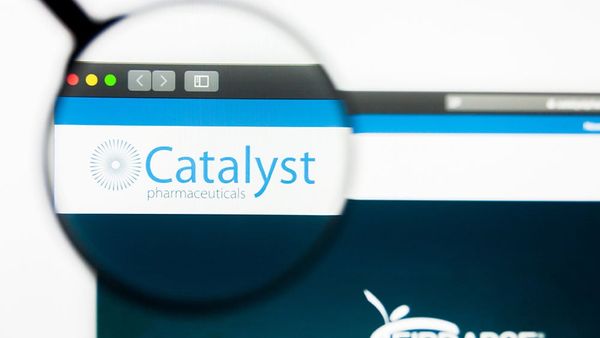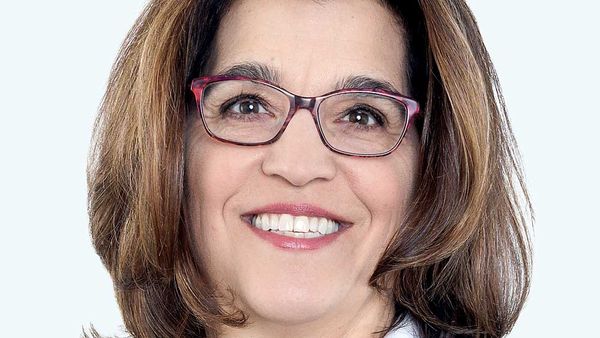Catalyst Pharmaceuticals' new Chief Executive, Richard Daly, is no stranger to working at big companies. But after cutting his teeth at Big Pharma stalwarts, including Takeda Pharmaceutical and AstraZeneca, he wanted something more.
In Daly's case, that meant going small.
Catalyst is not a pharma giant. Former CEO Patrick McEnany founded Catalyst in 2002 to license already or soon-to-be approved drugs in the rare diseases and central nervous system, or CNS, space. The biotech is focused on so-called orphan drugs, treatments for rare medical conditions.
The strategy has mostly paid off. Catalyst has expanded to three drugs for rare diseases. Sales skyrocketed between 79% and 98% in every quarter last year. Revenue growth in the first quarter of 2024 missed estimates, however, and advanced a more moderate 15.4%. Still, Catalyst doubled Wall Street's profit views.
Catalyst sells Firdapse, a treatment for a neuromuscular condition that often affects small cell lung cancer patients, a seizure treatment called Fycompa, and a Duchenne muscular dystrophy drug dubbed Agamree.
In an interview with Investor's Business Daily, Daly recalled how he had watched Catalyst Pharmaceuticals' transformation over the past nine years from his seat on the board of directors. He also explained why there are myriad benefits to working in a small company.
"I like staying small. Working in organizations as big as AstraZeneca or Bristol Myers Squibb — those are great experiences," he said. But "the opportunity to know and be known in your organization? I don't think there's anything like it."
This interview has been edited for brevity and clarity.
Next Steps For Catalyst Pharmaceuticals
IBD: Why did you decide to step into the CEO role?
Daly: I have watched the company evolve and I have been playing a pretty major role in that as a board member. My career is one that spans large companies. I have worked for divisions of Abbott Laboratories, Takeda, Bristol Myers Squibb and AstraZeneca in startup, scale-up and transformation opportunities. This was one that was really an opportunity to work in a real positive environment and a transformational opportunity going from one product to three products, and also taking advantage of the experience I have in international markets as well.
I ran all of Takeda's businesses in North and South America, and actually started Takeda's businesses in Canada, Mexico and Brazil. At Takeda, as an example, I was the 14th employee at Takeda in the U.S. and helped grow that company to 5,000 employees and $6 billion in business in the U.S. Then, I helped expand that business from just the U.S. to Canada, Mexico and Brazil. Those companies, under my leadership, became commercial organizations within the Takeda family, and launched their first products — going from white paper exercises to fully integrated commercial organizations.
So, I saw it as a great opportunity to help Catalyst take that next step as we expand internationally, as we look for that opportunity to expand the portfolio as a buy-and-build organization.
Focusing On Rare, Orphan Diseases
IBD: What goals do you have for Catalyst?
Daly: We love the orphan model. We love the opportunity to be really close to the patient. We enjoy that experience. I like staying small. Working in the organizations as big as AstraZeneca or BMS — those are great experiences. The opportunity to know and be known in your organization? I don't think there's anything like it. The last 10 years my career have been in small companies, focused companies. What we really want to do is focus on the orphan, rare space. Right now, we happen to be in (central nervous system disorders), which is great. But we look for the opportunity to expand in orphan CNS, but CNS-adjacent as well.
We're going to continue to look for opportunities that support the business and support the business model that we have. For example, we don't see ourselves expanding internationally and building a footprint that is a Catalyst footprint outside the U.S. We would continue to partner like we're doing. Unlike companies like Takeda that built an infrastructure outside the U.S., we would see ourselves partnering. So, we're going to have a different model than other companies might have.
Growth Plans Could Buoy Biotech Stock
IBD: What are your near-term plans?
Daly: We will continue to look for opportunities to deliver on the execution that we have — the commercial execution. As an example, with Firdapse, it's 15% to 20% growth over the near term, next one to three years. (We hope to) launch Agamree successfully. (Catalyst licensed the drug for treating Duchenne muscular dystrophy.) We're really excited about Agamree. And then looking for those immediately accretive or nearly immediately accretive opportunities to add to the portfolio in the orphan CNS or adjacent CNS opportunities. Really looking for those opportunities to continue to build out the portfolio. Just looking to help more patients and deliver more value for patients.
A Different Business Model From Other Biotech Stocks
IBD: Can you talk to me about your model? Your model is so different from other biotech companies.
Daly: We look to mitigate risk. There are a couple of ways to do this, obviously. You could go out and build research labs. I was recently at a conference where we were talking about the success rate of going from research to development to commercialization. And the opportunity, if you're in CNS, I think the success rate is probably in the 6% to 10% range. And then those products that get to market, only 50% of those actually make back the money it cost to get them there.
But if you're buying down the risk, we believe that this creates a better opportunity. We've mitigated all that clinical and essentially regulatory risk in our model because we're seeing how it plays out in the clinic. We're seeing how it essentially plays out in the regulatory space because we have access to all those regulatory interactions with the (Food and Drug Administration). With Agamree, we were able to see the regulatory interactions that Santhera Pharmaceuticals had with the FDA prior to making our final offer for the product as a partnership. So, we believe (that by) buying down the risk, we can make better decisions.
That's the way we approach the opportunities. We feel like we can then integrate it into a very efficient and effective commercial model. We think getting that accretive or nearly immediately accretive product in our portfolio is really beneficial for us, the patients and the shareholders.
How Catalyst Pharmaceuticals Is Working Backward
IBD: What's the earliest-stage product you are looking to acquire?
Daly: I think you'll see a morphing of our portfolio. You saw when we had just Firdapse, we had one source of revenue. So, we went out and bought Fycompa, which was an epilepsy product.
And we did that for a couple of reasons. One, it brought a lot of talent to our organization. Epilepsy is a very complex and competitive area. But it also diversified our income stream as well. It's a stable product so it gave us a lot of stability and diversification in our pipeline. That was an on-the-market product. Then, you see us working our way back in the pipeline, and we got Agamree, which was a (New Drug Application)-filed product. So, we're starting to work our way back.
When we have more stability in our revenue line, we can take a little bit more risk. And it's a thoughtful approach. As we build that diversity, and that stability in our income line, we can take a little bit more risk, and we can be thoughtful about it. Right now, we want to be in that end-of-Phase 3 (testing), preparing to file the NDA, or NDA-filed place. As we build out that portfolio, we can still take a little bit more risk and go back further into the pipeline. Taking a little bit more risk, paying a little less and then having more potential.
Is Big Pharma Going To Compete?
IBD: For a small biotech company, you're certainly taking a Big Pharma tactic. How do you view that?
Daly: The slice that we're looking for is probably not of interest to Big Pharma companies. So when we look at the size of the opportunity, our base is such that we don't need a giant opportunity to continue to grow at 15% or 20% a year, whereas a larger company needs a much bigger opportunity.
Because our execution is so good — and having been on the buy side of a lot of these products — when you're giving up a product, you're giving up your child, if you will. You only have one shot at launching a product. You want to be sure you're giving it to a partner that can execute. This becomes really, really important. As somebody who has launched more than 10 products, you only have that one shot. So, you want to look at the performance of that company. And our performance is second to none.
We believe we have that capability, we have the infrastructure. We believe, beyond just the financial opportunity the partner might have, they can put it in our hands and rest assured that we can execute.
Biotech Stock Investors Watch The CNS Space
IBD: Why the CNS space?
Daly: CNS is a really interesting area right now. Between now and 2025, CNS is forecast to grow by 100%. So, it's a fast-growing area. It has less competition for assets. That, we believe, will change over time. We believe it's going to become more competitive. That's why we say, "CNS, rare today, but also adjacent." We believe our infrastructure — helping the patient get on and stay on (treatment) — is applicable to any rare disease.
So, while we're building our bones right now on CNS, we expect to be able to migrate to any orphan space, and use the infrastructure we have. While each orphan condition is unique, we believe there are essential elements to the orphan condition that are applicable across. Probably 80%, 85% of the requirements to be successful in an orphan condition are common. So, the growth that CNS represents — the opportunity that's there — we believe is good for us.
Over time, we believe that the competition will come to this space and we can play in that space. But we will also look for opportunities beyond CNS and grow those other opportunities.
What's Next For Catalyst Pharmaceuticals?
IBD: What opportunities would you look for beyond CNS?
Daly: I think cardiovascular is a strong space. In the late 80s and early 90s, cardiovascular was overwhelmed and highly competitive. I think that's changed. But I think there's a great deal of interest there now. I think there's a lot of good research there. I think diabetes is a really interesting space. I have experience in both those spaces, and I think that's an up-and-comer as well. We see that with the GLP-1s. I worked in that space 10 years ago at AstraZeneca. I think that's really interesting. Not that we would compete in the GLP-1 space. We would be looking for orphan and rare opportunities in cardiovascular and diabetes space as well.
Follow Allison Gatlin on X, the platform formerly known as Twitter, at @IBD_AGatlin.










